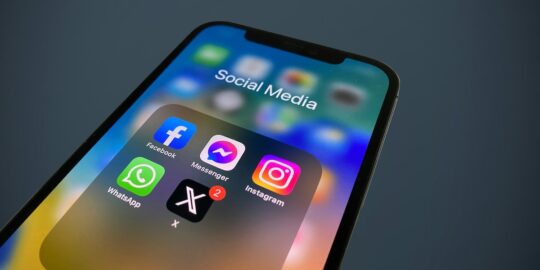
How Can Interactive Whiteboard Alternatives Fit Into Your School District’s Classroom?
Interactive whiteboards have been commonplace in the classroom for over a decade and have undergone many changes. With the interactive display market experiencing rapid growth, innovations have changed the landscape and encouraged fierce competition among interactive whiteboard alternatives. The interactive display market is set to increase to at least $87 billion by 2030. While the growth accounts for more than educational technology, there are new alternatives to investigate if your school district is considering replacing its interactive display technology.
This blog will guide you when choosing an alternative to your district’s interactive displays. We will discuss how the technology has evolved, how new technology can enhance the classroom experience and the current interactive whiteboard alternatives.
How Has Interactive Whiteboard Technology Evolved?
Your school district may have used interactive whiteboards in the past. They rely on a projector to display the image and allow teachers and students to manipulate the screen using a finger or a specialized stylus similar to a dry-erase marker. Educators can use display technology to enhance lessons by improving the engagement of the presentation format. They can also call students up to the board to share in the interaction and create a more collaborative educational environment.
If the interactive whiteboard your school district uses in the classroom is older, you may be surprised how they have changed. Software and features have made the experience more social and connected, offering similar applications and internet-enabled capabilities to interactive flat panels. The components have also changed, offering energy-efficient LED projection rather than traditional incandescent lighting.
Virtual whiteboards or digital whiteboards are also a recent update to the technology. They allow the teacher to interact with the whiteboard while students follow along in a remote classroom environment.
Related: The Digital Interactive Classroom of Today
Why Consider an Alternative to Your District’s Interactive Displays?
While interactive whiteboards offer a variety of features to improve classroom engagement and have evolved considerably throughout the years, they have shortcomings that have led school districts to switch to different technologies. School districts chose alternatives because of the poor mobility of the display system, expensive and frequent maintenance, and the accessibility of contemporary interactive whiteboard alternatives.
Mobility
Interactive whiteboards can be a challenge to move. While some classrooms will not need to move their display often, modular classrooms may have to rely on workarounds or call IT frequently to move the stationary device. Two primary components of the display —the screen and the projector—must be together for it to work. Interactive flat panels and other alternatives are more mobile and space-saving, only requiring an outlet and proximity to the presentation device.
Maintenance
Interactive whiteboards require calibration to ensure the teacher and students can interact with the device easily. District IT may need to visit each classroom to calibrate the whiteboard frequently or instruct educators to calibrate the board if necessary. They also require expensive bulb replacements using older incandescent lightbulbs rather than new LED technology.
Old Technology
If your district invested in interactive whiteboards, they likely procured them more than a decade ago. It may be time to let go of the old displays in exchange for newer, more compatible, energy-efficient, and streamlined technology. Outdated technology can be a primary frustration for teachers and increase helpdesk tickets. Removing obsolete and incompatible displays from your district’s EdTech stack may be the best option.
Alternatives to Interactive Whiteboards
Several options can fit various budgets and requirements if you consider interactive whiteboard alternatives for your school district. You can switch to a new and more compatible display solution or continue to use the whiteboard by refreshing it with technology that complements the display.
Traditional Displays and Projectors (Non-Interactive)
While they don’t offer the interactivity of an interactive whiteboard and many other alternatives, traditional display devices are still present in many classrooms. They include HD televisions, projectors, and other display devices that lack interactive features. Educators can still manipulate the main display from their desk or a podium using a cable or a screen casting solution.
Using a traditional display has significant limitations, from device and software compatibility to a lack of interactivity and engagement. Often traditional displays are the least desirable solution for enhancing the social classroom experience.
Individual or Shared Devices
In the modern classroom, mobile devices are commonplace. While educators once saw mobile devices as a distraction, they became a vital learning tool during the pandemic, with many school districts implementing one-to-one or one-device-per-student programs to facilitate the virtual classroom. A survey from Education Week found that most school districts invested some money in devices, and 74% invested a significant amount in them to address the pandemic constraints. Nearly 90% of middle and high school educators surveyed said they have a one-to-one ratio of devices per student.
When combined with a learning management system, mobile devices can help students better understand learning materials in the classroom. Individual display devices can facilitate a social environment in the classroom using a screen-sharing application so students can follow the teacher’s screen or a digital whiteboard app. While a one-to-one program can be cost-prohibitive for many schools, smaller displays on mobile carts may be a more affordable alternative. Classrooms are experimenting with mobile displays on carts for students to break out into smaller groups to work on collaborative assignments. However, finding space for several carts in the classroom can be challenging.
While working from individual devices like tablets can be suitable for independent work, it offers a less collaborative experience, even with screen-sharing software. A primary display where every student can focus on solving a problem or answer a question through discussion provides a more collaborative experience. It can build skills students will need in the future workplace.
Interactive Flat Panels
Interactive flat panels are a considerable step up from individual devices and non-interactive displays when building the social classroom. They make up a significant market share in education and continue to grow in popularity as school districts return to in-person classrooms. Flat panels offer more seamless interactivity than older whiteboard technology, relying on a touch-sensitive screen rather than a projection setup to provide a better experience overall.
Most interactive flat panels can also connect to the internet, allowing educators to display content without additional devices. Screen casting enables the teacher to move around the room when sharing a device’s screen, but compatibility and low resolution can be an issue, depending on the device in use.
Wireless Screen Mirroring
Wireless screen mirroring is an alternative to a new interactive whiteboard that works with your school district’s existing displays and digital signage, from projectors to interactive flat panels. It can reduce the time and cost of implementing new display technology.
Wireless screen mirroring solutions are software and hardware-agnostic, preventing compatibility issues and allowing teachers and students to use any device that can connect to the classroom’s wireless access point. IT will not need to convert software or file types with a new system, as wireless screen mirroring is compatible with the teacher’s and students’ devices. It can also mean much less training and fewer helpdesk tickets. IT administrators can control access and display content from a central location, allowing the district to make announcements to thousands of displays at once.
Teachers and students can connect to the main display from anywhere in the classroom without being tethered by an AV cable. Wireless screen mirroring allows the teacher to interact with students throughout the room and continue the presentation. It will enable students to connect to the display simultaneously for an engaging social experience.
Related: Can an Interactive Flat Panel Alternative Revitalize the Social Classroom Experience?
Refresh Your School District’s Interactive Whiteboards With Wireless Screen Mirroring
If your school district wants to keep its old interactive whiteboards rather than turning to an alternative, pairing the displays with a wireless screen mirroring solution can improve their functionality, user-friendliness, and compatibility. The solutions typically use a simple interface that teachers and students can grasp quickly, and users require less training before rolling out the technology and experience fewer frustrations. Wireless screen mirroring solutions are hardware and software agnostic, and they help aging interactive displays keep up with modern devices, preventing compatibility issues.
Upgrading your district’s interactive displays with a wireless screen mirroring solution improves the display’s function and compatibility without replacing them entirely, making it a more cost-effective solution. Wireless screen mirroring can be a long-term solution, and it offers compatibility with the latest devices for the foreseeable future as long as they use Wi-Fi.
The Ideal Alternative to Your School District’s Aging Interactive Whiteboards
If your district’s interactive whiteboards need replacement soon, consider an alternative to alleviate some of the frustrations teachers, students, and your IT department face when implementing and using the display technology. Many options are available, with greater useability, compatibility, and economy than the aging technology. The ideal replacement should allow teachers and students to use the primary display and offer centralized IT management seamlessly. It should also be compatible with all the software and devices used in the classroom.A wireless screen mirroring is an interactive whiteboard alternative that satisfies educators and students without putting a burden on district IT. Vivi is a wireless screen mirroring solution that more than half a million teachers and students use in the classroom. It offers seamless compatibility with software and hardware agnostic interface that allows teachers and students to display their device and software on the screen wirelessly. District IT can configure, update, and manage Vivi from a central database to permit access to the displays and show districtwide announcements. Book a demo to try Vivi in the classroom today.



